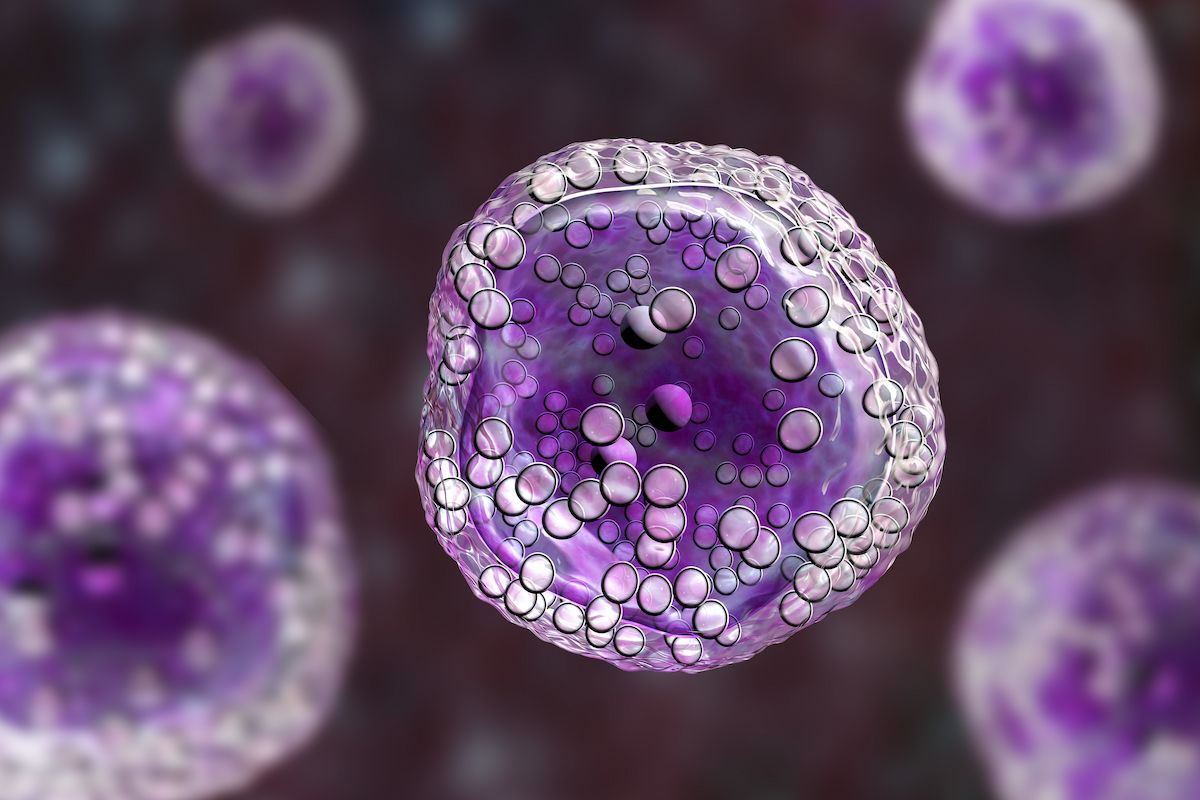BET Inhibitor Combo Yields Robust Spleen Volume Reduction, Acceptable Safety
Most treatment-related adverse effects were low-grade following treatment with BMS-986158 plus ruxolitinib or fedratinib in a population of patients with intermediate- or high-risk myelofibrosis.

Treatment with BET inhibitor BMS-986158 plus ruxolitinib (Jakafi) or fedratinib (Inrebic) resulted in a notable reduction in splenic volume with a manageable safety profile, according to data from the phase 1/2 CA011-023 study (NCT04817007) presented at the 2023 European Hematology Association (EHA) Congress.
Any-grade treatment-related adverse effects (TRAEs) occurred in 82% of patients in part 1A of the study—assessing BMS-986158 plus ruxolitinib—and 75% in part 1B—assessing BMS-986158 plus fedratinib. The most common grade 3/4 TRAEs that occurred in part 1A were thrombocytopenia (45%), neutropenia (9%), hypertension (9%), and anemia (9%). In part 1B, common high-grade TRAEs included thrombocytopenia (42%), anemia (42%), diarrhea (8%), blood bilirubin increase (8%).
Dose limiting toxicities (DLTs) were observed in 2 patients in part 1A and 3 patients in 1B. In part 1A, both DLTs were thrombocytopenia, which resulted in a BMS-986158 dose reduction in both the 2.0 mg and 3.75 mg cohorts, respectively. DLTs in part 1B included diarrhea, thrombocytopenia, and elevated bilirubin, all of which was observed in the 1.25 mg cohort.
A reduction in splenic volume was reported among all patients in part 1A and became more robust at week 24. In this cohort of patients, 83% of those who received BMS-986158 at 2.0 mg 3.0 mg plus ruxolitinib met SVR35 at week 12 and 100% met SVR at week 24. No patients in part 1B who were treated with BMS-986158 at 0.50 mg and 0.75 mg and fedratinib met SVR35 at 12 weeks and 33% met SVR35 at week 24. Those in part 1B received lower dose levels of BMS-986158 than part 1A.
Investigators also did a JAK2 VAF analysis, which highlighted a reduction in JAK2V617F frequency in both parts, including a max reduction of 35% by C10 in part 1A and 22% by C7 in part 1B.
BMS-986158 is an oral, bioavailable, potent, selective small molecule BET inhibitor that is currently being evaluated alone and in combination with the JAK inhibitors ruxolitinib or fedratinib in a population of patients with myelofibrosis.
The CA011-023 study included dose-escalation in parts 1A and 1B and dose-expansion at the recommended phase 2 dose; the dose-expansion portion of the trial will assess BMS-986158 plus ruxolitinib in part 2A and BMS-986158 with or without fedratinib in part 2B. To be eligible for the trial, patients are required to have primary or secondary myelofibrosis, splenomegaly defined as a splenic volume of 450 cm3 or more, an ECOG performance status of 0 to 2, and Dynamic International Prognostic Scoring System risk scores of intermediate-1 plus symptoms, intermediate-2, or high.
Those in part 1A of the trial received BMS‑986158 at a dose of 2.0 mg, 3.0 mg, or 3.75 mg daily according to a 5 days on, 2 days off schedule, plus 15 mg of ruxolitinib. In part 1B, dose levels of BMS‑986158 included 0.5 mg, 0.75 mg, and 1.25 mg daily according to a 5 days on, 2 days off schedule; this population also received fedratinib at a dose of 400 mg daily.
The dose-escalation’s primary end points were safety, tolerability, and identification of the maximum tolerated dose and/or recommended phase 2 dose of BMS‑986158 plus ruxolitinib or fedratinib. The study’s secondary end point was spleen volume reduction.
A total of 23 patients were treated in the study, including 11 in part 1A and 12 in part 1B. The median age in each respective arm was 67 years (range, 36-81) and 69 years (range, 37-77).
Reference
Ayala R, Lopez N, Abulafia AS, et al. BMS-986158, a potent BET inhibitor, as monotherapy and in combination with ruxolitinib or fedratinib in intermediate- or high-risk myelofibrosis (MF): results from a phase 1/2 study. Presented at the 2023 European Hematology Association Congress; Frankfurt, Germany. June 8-11, 2023. Abstract S213.
Newsletter
Stay up to date on recent advances in the multidisciplinary approach to cancer.